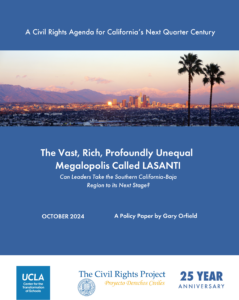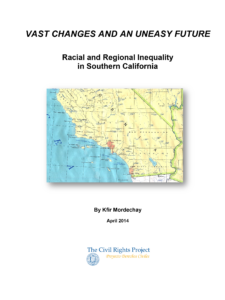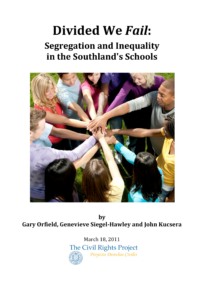The LASANTI Project is particularly interested in the demographic transformation and profound inequalities and separations that exist along racial, ethnic, linguistic, and social class lines. It’s most basic questions concern the structure of opportunities for the coming generations. LASANTI is a huge, mutually dependent and interrelated area, divided by national and municipal boundaries, by politics, by race, ethnicity and poverty, by media, by language, by coastal and inland locations and, sometimes, by fear. The region is in a period of dramatic change along many dimensions. Trends show that it is likely to become more polarized and less able to realize its promise, especially if existing trends continue.
The first four studies are:
- “Divided We Fail: Segregation and Inequality in the Southland’s Schools,”
- “Fragmented Economy, Stratified Society and the Shattered Dream,”
- “Unrealized Promises: Unequal Access, Affordability and Excellence at Community Colleges in Southern California”
- “Vast Changes and an Uneasy Future: Racial and Regional Inequality in Southern California.”
Later studies incorporate findings from the 2010 Census in both countries and will look at housing opportunity, educational opportunities across the entire region, health care inequalities in particular sectors, attitudes and aspirations in the region and, perhaps, along other dimensions.
The research began in an interdepartmental two-quarter seminar at UCLA dedicated to trying to understand the region and the threats to its future stemming from the failure to effectively educate and employ most young people across the region. In a period of general economic crisis and slashes in government, these changes have gone very far without being confronted seriously. Too many policies that ignore the changing nature of the region only serve to deepen inequalities. We are on a path to exclude most of the next generation from opportunities to securely enter the middle class, policies which will produce a decline in Southern California’s average educational levels, which is virtually certain to produce a decline in economic success. This is a path leading to decay and division.
The issues raised by these studies are not addressed in the political debate going on today in the region. Decisions taken to solve the immediate fiscal crisis or to win the next election are important but a larger vision is essential. There are very costly long-term consequences of doing nothing about fundamental structural inequities, and these are exactly the kinds of issues universities can help illuminate. The LASANTI project studies the racial and ethnic transformation and destiny of a vast community. Our goal is to produce a series of solid, scholarly reports, clearly written with accurate data that make evident the scale of the transformations and the choices before the region.
We hope these reports get citizens and policymakers thinking in terms of decades or generations and focusing on the most fundamental question—how can we make a good and successful transition (to an equitable and inclusive region) in a society of constantly growing diversity?
The LASANTI region is where the great forces of Latino society, white European-American history, Asian societies, and a large African American community all come together far more dramatically than in any other great urban complex. It can become a troublesome puzzle of deepening separation and lost opportunity, or a place where these forces unite, where our institutions respect and draw on the richness of diversity, and where we prepare the coming generations to be at the forefront of creativity and innovation for the nation and the hemisphere. If it is to be a successful society with a strong middle class, and if it is to continue to gain in education and human capital, it must open doors that today remain shut. It must educate and bring into the mainstream groups who have been largely excluded from the best that California has to offer. These studies are addressed to those who want to think about broad systemic issues and begin to create a consciousness of the challenges before our region. Our hope is to fuel debates about policies that could turn us from deepening separation and decline towards fostering a just and vital community, a model for both the U.S. and Mexico.
In compliance with the UC Open Access Policy, this report has been made available on eScholarship:




